Louis Philippe I
Louis Philippe I (6 October 1773 – 26 August 1850) was King of the French from 1830 to 1848 and the last king of France. As Duke of Chartres he distinguished himself commanding troops during the Revolutionary Wars, but broke with the Republic over its decision to execute King Louis XVI. He fled to Switzerland in 1793 after being connected with a plot to restore France's monarchy. His father Louis Philippe II, Duke of Orléans (Philippe Égalité) fell under suspicion and was executed, and Louis Philippe remained in exile for 21 years until the Bourbon Restoration. He was proclaimed king in 1830 after his cousin Charles X was forced to abdicate by the July Revolution. The reign of Louis Philippe is known as the July Monarchy and was dominated by wealthy industrialists and bankers. He followed conservative policies, especially under the influence of French statesman François Guizot during the period 1840–48. He also promoted friendship with Britain and sponsored colonial expansion, notably the French conquest of Algeria. His popularity faded as economic conditions in France deteriorated in 1847, and he was forced to abdicate after the outbreak of the French Revolution of 1848. He lived out his life in exile in the United Kingdom. His supporters were known as Orléanists, as opposed to Legitimists who supported the main line of the House of Bourbon.
| Louis Philippe I | |||||
|---|---|---|---|---|---|
_by_Winterhalter.jpg) Portrait by Franz Xaver Winterhalter, 1841 | |||||
| King of the French | |||||
| Reign | 9 August 1830 – 24 February 1848 | ||||
| Proclamation | 9 August 1830 | ||||
| Predecessor | Charles X as King of France | ||||
| Successor | Monarchy abolished Jacques Dupont de l'Eure as Head of the Provisional Government | ||||
| Prime Ministers | See list
| ||||
| Duke of Orléans First Prince of the Blood | |||||
| Tenure | 6 November 1793 – 9 August 1830 | ||||
| Predecessor | Louis Philippe | ||||
| Successor | Ferdinand Philippe | ||||
| Born | 6 October 1773 Palais Royal, Paris, Kingdom of France | ||||
| Died | 26 August 1850 (aged 76) Claremont, Surrey, England | ||||
| Burial | 1876 | ||||
| Spouse | |||||
| Issue see detail... |
| ||||
| |||||
| House | Orléans | ||||
| Father | Louis Philippe II, Duke of Orléans | ||||
| Mother | Louise Marie Adélaïde de Bourbon | ||||
| Religion | Roman Catholicism | ||||
| Signature | |||||
Before the Revolution (1773–1789)
Early life
_in_ceremonial_robes_of_the_Order_of_the_Holy_Spirit_by_Antoine_Fran%C3%A7ois_Callet.jpg)
Louis Philippe was born in the Palais Royal, the residence of the Orléans family in Paris, to Louis Philippe, Duke of Chartres (Duke of Orléans, upon the death of his father Louis Philippe I), and Louise Marie Adélaïde de Bourbon. As a member of the reigning House of Bourbon, he was a Prince of the Blood, which entitled him the use of the style "Serene Highness". His mother was an extremely wealthy heiress who was descended from Louis XIV of France through a legitimized line.
Louis Philippe was the eldest of three sons and a daughter, a family that was to have erratic fortunes from the beginning of the French Revolution to the Bourbon Restoration.
The elder branch of the House of Bourbon, to which the kings of France belonged, deeply distrusted the intentions of the cadet branch, which would succeed to the throne of France should the senior branch die out. Louis Philippe's father was exiled from the royal court, and the Orléans confined themselves to studies of the literature and sciences emerging from the Enlightenment.
Education
Louis Philippe was tutored by the Countess of Genlis, beginning in 1782. She instilled in him a fondness for liberal thought; it is probably during this period that Louis Philippe picked up his slightly Voltairean brand of Catholicism. When Louis Philippe's grandfather died in 1785, his father succeeded him as Duke of Orléans and Louis Philippe succeeded his father as Duke of Chartres.
In 1788, with the Revolution looming, the young Louis Philippe showed his liberal sympathies when he helped break down the door of a prison cell in Mont Saint-Michel, during a visit there with the Countess of Genlis. From October 1788 to October 1789, the Palais Royal was a meeting-place for the revolutionaries.
Revolution (1789–1793)
Louis Philippe grew up in a period that changed Europe as a whole and, following his father's strong support for the Revolution, he involved himself completely in those changes. In his diary, he reports that he himself took the initiative to join the Jacobin Club, a move that his father supported.
Military service
.jpg)
In June 1791, Louis Philippe got his first opportunity to become involved in the affairs of France. In 1785, he had been given the hereditary appointment of Colonel of the Chartres Dragoons (renamed 14th Dragoons in 1791).[1]
With war imminent in 1791, all proprietary colonels were ordered to join their regiments. Louis Philippe showed himself to be a model officer, and he demonstrated his personal bravery in two famous instances. First, three days after Louis XVI's flight to Varennes, a quarrel between two local priests and one of the new constitutional vicars became heated, and a crowd surrounded the inn where the priests were staying, demanding blood. The young colonel broke through the crowd and extricated the two priests, who then fled. At a river crossing on the same day, another crowd threatened to harm the priests. Louis Philippe put himself between a peasant armed with a carbine and the priests, saving their lives. The next day, Louis Philippe dived into a river to save a drowning local engineer. For this action, he received a civic crown from the local municipality. His regiment was moved north to Flanders at the end of 1791 after the 27 August 1791 Declaration of Pillnitz.
Louis Philippe served under his father's crony, Armand Louis de Gontaut the Duke of Biron, along with several officers who later gained distinction afterwards. These included Colonel Berthier and Lieutenant Colonel Alexandre de Beauharnais (husband of the future Empress Joséphine).
After war was declared by the Kingdom of France on the Habsburg Monarchy on 20 April 1792, Louis Philippe saw his first exchanges of fire of the French Revolutionary Wars within the invaded by France Austrian Netherlands at Boussu, Walloon, on about 28 April 1792, and then at Quaregnon, Walloon, on about 29 April 1792, and then at Quiévrain, Walloon, near Jemappes, Walloon, on about 30 April 1792, where he was instrumental in rallying a unit of retreating soldiers after the victorious Battle of Quiévrain (1792) only two days earlier on 28 April 1792. Biron wrote to War Minister de Grave, praising the young colonel, who was then promoted to brigadier, commanding a brigade of cavalry in Lückner's Army of the North.
In the Army of the North, Louis Philippe served with four future Marshals of France: Macdonald, Mortier (who would later be killed in an assassination attempt on Louis Philippe), Davout and Oudinot. Dumouriez was appointed to command the Army of the North in August 1792. Louis Philippe commanded a division under him in the Valmy campaign.
At the 20 September 1792 Battle of Valmy, Louis Philippe was ordered to place a battery of artillery on the crest of the hill of Valmy. The battle was apparently inconclusive, but the Austrian-Prussian army, short of supplies, was forced back across the Rhine. Once again, Louis Philippe was praised in a letter by Dumouriez after the battle. Louis Philippe was then recalled to Paris to give an account of the Battle at Valmy to the French government. There he had a rather trying interview with Danton, the Minister of Justice, which he later fondly re-told to his children.
While in Paris, he was promoted to the rank of lieutenant-general. In October he returned to the Army of the North, where Dumouriez had begun a march into the Austrian Netherlands (now Belgium). Louis Philippe again commanded a division. On 6 November 1792, Dumouriez chose to attack an Austrian force in a strong position on the heights of Cuesmes and Jemappes to the west of Mons. Louis Philippe's division sustained heavy casualties as it attacked through a wood, retreating in disorder. Louis Philippe rallied a group of units, dubbing them "the battalion of Mons" and pushed forward along with other French units, finally overwhelming the outnumbered Austrians.
Events in Paris undermined the budding military career of Louis Philippe. The incompetence of Jean-Nicolas Pache, the new Girondist appointee of 3 October 1792, left the Army of the North almost without supplies. Soon thousands of troops were deserting the army. Louis Philippe was alienated by the more radical policies of the Republic. After the National Convention decided to put the deposed King to death, Louis Philippe's father – by then known as Philippe Égalité – voted in favour of that act, Louis Philippe began to consider leaving France.
Louis Philippe was willing to stay in France to fulfill his duties in the army, but he was implicated in the plot Dumouriez had planned to ally with the Austrians, march his army on Paris, and restore the Constitution of 1791. Dumouriez had met with Louis Philippe on 22 March 1793 and urged his subordinate to join in the attempt.
With the French government falling into the Reign of Terror about the time of the creation of the Revolutionary Tribunal earlier in March 1793, he decided to leave France to save his life. On 4 April, Dumouriez and Louis Philippe left for the Austrian camp. They were intercepted by Lieutenant-Colonel Louis-Nicolas Davout, who had served at Jemappes with Louis Philippe. As Dumouriez ordered the Colonel back to the camp, some of his soldiers cried out against the General, now declared a traitor by the National Convention. Shots rang out as they fled towards the Austrian camp. The next day, Dumouriez again tried to rally soldiers against the Convention; however, he found that the artillery had declared itself in favour of the Republic, leaving him and Louis Philippe with no choice but to go into exile.
At the age of nineteen, and already a Lieutenant General, Louis Philippe left France; it was some twenty-one years before he again set foot on French soil.
Exile (1793–1815)
_%C3%A0_Reichenau.jpg)
The reaction in Paris to Louis Philippe's involvement in Dumouriez's treason inevitably resulted in misfortunes for the Orléans family. Philippe Égalité spoke in the National Convention, condemning his son for his actions, asserting that he would not spare his son, much akin to the Roman consul Brutus and his sons. However, letters from Louis Philippe to his father were discovered in transit and were read out to the Convention. Philippe Égalité was then put under continuous surveillance. Shortly thereafter, the Girondists moved to arrest him and the two younger brothers of Louis Philippe, Louis-Charles and Antoine Philippe; the latter had been serving in the Army of Italy. The three were interned in Fort Saint-Jean in Marseille.
Meanwhile, Louis Philippe was forced to live in the shadows, avoiding both pro-Republican revolutionaries and Legitimist French émigré centres in various parts of Europe and also in the Austrian army. He first moved to Switzerland under an assumed name, and met up with the Countess of Genlis and his sister Adélaïde at Schaffhausen. From there they went to Zürich, where the Swiss authorities decreed that to protect Swiss neutrality, Louis Philippe would have to leave the city. They went to Zug, where Louis Philippe was discovered by a group of émigrés.
It became quite apparent that for the ladies to settle peacefully anywhere, they would have to separate from Louis Philippe. He then left with his faithful valet Baudouin for the heights of the Alps, and then to Basel, where he sold all but one of his horses. Now moving from town to town throughout Switzerland, he and Baudouin found themselves very much exposed to all the distresses of extended travelling. They were refused entry to a monastery by monks who believed them to be young vagabonds. Another time, he woke up after spending a night in a barn to find himself at the far end of a musket, confronted by a man attempting to keep away thieves.
Throughout this period, he never stayed in one place more than 48 hours. Finally, in October 1793, Louis Philippe was appointed a teacher of geography, history, mathematics and modern languages, at a boys' boarding school. The school, owned by a Monsieur Jost, was in Reichenau, a village on the upper Rhine in the then independent Grisons league state, now part of Switzerland. His salary was 1,400 francs and he taught under the name Monsieur Chabos. He had been at the school for a month when he heard the news from Paris: his father had been guillotined on 6 November 1793 after a trial before the Revolutionary Tribunal.
Travels
GeorgeDawe.jpg)
After Louis Philippe left Reichenau, he separated the now sixteen-year-old Adélaïde from the Countess of Genlis, who had fallen out with Louis Philippe. Adélaïde went to live with her great-aunt the Princess of Conti at Fribourg, then to Bavaria and Hungary and, finally, to her mother, who was exiled in Spain.
Louis Philippe travelled extensively. He visited Scandinavia in 1795 and then moved on to Finland. For about a year, he stayed in Muonio, a remote village in the valley of the Tornio river in Lapland. He lived in the rectory under the name Müller, as a guest of the local Lutheran vicar. While visiting Muonio, he supposedly sired a child with Beata Caisa Wahlborn (1766–1830) called Erik Kolstrøm (1796–1879).[2]
Louis Philippe also visited the United States for four years, staying in Philadelphia (where his brothers Antoine and Louis Charles were in exile), New York City (where he most likely stayed at the Somerindyck family estate on Broadway and 75th Street with other exiled princes), and Boston. In Boston, he taught French for a time and lived in lodgings over what is now the Union Oyster House, Boston's oldest restaurant. During his time in the United States, Louis Philippe met with American politicians and people of high society, including George Clinton, John Jay, Alexander Hamilton, and George Washington.
His visit to Cape Cod in 1797 coincided with the division of the town of Eastham into two towns, one of which took the name of Orleans, possibly in his honour. During their sojourn, the Orléans princes travelled throughout the country, as far south as Nashville and as far north as Maine. The brothers were even held in Philadelphia briefly during an outbreak of yellow fever. Louis Philippe is also thought to have met Isaac Snow of Orleans, Massachusetts, who had escaped to France from a British prison hulk during the American Revolutionary War. In 1839, while reflecting on his visit to the United States, Louis Philippe explained in a letter to Guizot that his three years there had a large influence on his political beliefs and judgments when he became king.
In Boston, Louis Philippe learned of the coup of 18 Fructidor (4 September 1797) and of the exile of his mother to Spain. He and his brothers then decided to return to Europe. They went to New Orleans, planning to sail to Havana and thence to Spain. This, however, was a troubled journey, as Spain and Great Britain were then at war. While in colonial Louisiana in 1798, they were entertained by Julien Poydras in the town of Pointe Coupée,[3] as well as by the Marigny de Mandeville family in New Orleans.
They sailed for Havana in an American corvette, but the ship was stopped in the Gulf of Mexico by a British warship. The British seized the three brothers, but took them to Havana anyway. Unable to find passage to Europe, the three brothers spent a year in Cuba, until they were unexpectedly expelled by the Spanish authorities. They sailed via the Bahamas to Nova Scotia where they were received by the Duke of Kent, son of King George III and (later) father of Queen Victoria. Louis Philippe struck up a lasting friendship with the British royal. Eventually, the brothers sailed back to New York, and in January 1800, they arrived in England, where they stayed for the next fifteen years. During these years, Louis Philippe taught mathematics and geography at the now-defunct Great Ealing School, reckoned, in its nineteenth-century heyday, to be 'the best private school in England'.[4][5]
Marriage
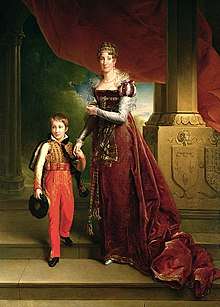
In 1796, Louis Philippe supposedly fathered a child with Beata Caisa Wahlborn (1766–1830) named Erik Kolstrøm (1796–1879).[2]
In 1808, Louis Philippe proposed to Princess Elizabeth, daughter of King George III of the United Kingdom. His Catholicism and the opposition of her mother Queen Charlotte meant the Princess reluctantly declined the offer.[6]
In 1809, Louis Philippe married Princess Maria Amalia of Naples and Sicily, daughter of King Ferdinand IV of Naples and Maria Carolina of Austria. The ceremony was celebrated in Palermo 25 November 1809. The marriage was considered controversial, because she was the niece of Marie Antoinette, while he was the son of Louis Philippe II, Duke of Orléans who was considered to have played a part in the execution of her aunt. Her mother was skeptical to the match for the same reason. She had been very close to her younger sister and devastated by her execution, but she had given her consent after he had convinced her that he was determined to compensate for the mistakes of his father, and after having agreed to answer all her questions regarding his father.[7]
Bourbon Restoration (1815–1830)
_duc_d'Orl%C3%A9ans_en_uniforme_de_colonel-g%C3%A9n%C3%A9ral_des_Hussards%2C_repr%C3%A9sent%C3%A9_en_1817.jpg)
After the abdication of Napoleon, Louis Philippe, known as Louis Philippe, Duke of Orléans, returned to France during the reign of his cousin Louis XVIII, at the time of the Bourbon Restoration. Louis Philippe had reconciled the Orléans family with Louis XVIII in exile, and was once more to be found in the elaborate royal court. However, his resentment at the treatment of his family, the cadet branch of the House of Bourbon under the Ancien Régime, caused friction between him and Louis XVIII, and he openly sided with the liberal opposition.
Louis Philippe was on far friendlier terms with Louis XVIII's brother and successor, Charles X, who acceded to the throne in 1824, and with whom he socialized. However, his opposition to the policies of Villèle and later of Jules de Polignac caused him to be viewed as a constant threat to the stability of Charles' government. This soon proved to be to his advantage.
King of the French (1830–1848)
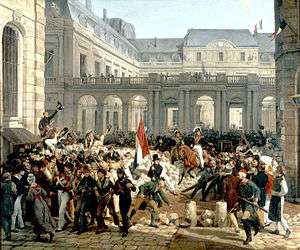
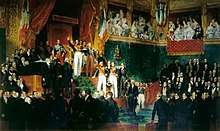
In 1830, the July Revolution overthrew Charles X, who abdicated in favour of his 10-year-old grandson, Henri, Duke of Bordeaux, and, naming Louis Philippe Lieutenant général du royaume, charged him to announce to the popularly elected Chamber of Deputies his desire to have his grandson succeed him. Louis Philippe did not do this, in order to increase his own chances of succession. As a consequence, because the chamber was aware of Louis Philippe's liberal policies and of his popularity with the masses, they proclaimed Louis Philippe, who for eleven days had been acting as the regent for his young cousin, as the new French king, displacing the senior branch of the House of Bourbon.
Charles X and his family, including his grandson, went into exile in Britain. The young ex-king, the Duke of Bordeaux, who, in exile, took the title of comte de Chambord, later became the pretender to the throne of France and was supported by the Legitimists.
Louis-Philippe was sworn in as King Louis-Philippe I on 9 August 1830.[8] Upon his accession to the throne, Louis Philippe assumed the title of King of the French – a title already adopted by Louis XVI in the short-lived Constitution of 1791. Linking the monarchy to a people instead of a territory (as the previous designation King of France and of Navarre) was aimed at undercutting the legitimist claims of Charles X and his family.
By an ordinance he signed on 13 August 1830,[n 1] the new king defined the manner in which his children, as well as his "beloved" sister, would continue to bear the surname "d'Orléans" and the arms of Orléans, declared that his eldest son, as Prince Royal (not Dauphin), would bear the title Duke of Orléans, that the younger sons would continue to have their previous titles, and that his sister and daughters would only be styled Princesses of Orléans, not of France.
His ascension to the title of King of the French was seen as a betrayal by Emperor Nicholas I of Russia, and it ended their friendship.
In 1832, his daughter, Princess Louise-Marie, married the first ruler of Belgium, Leopold I, King of the Belgians. Their descendants include all subsequent Kings of the Belgians, as well as Empress Carlota of Mexico.
Rule
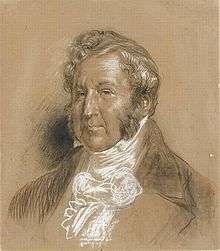
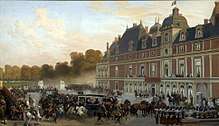
Louis Philippe ruled in an unpretentious fashion, avoiding the pomp and lavish spending of his predecessors. Despite this outward appearance of simplicity, his support came from the wealthy bourgeoisie. At first, he was much loved and called the "Citizen King" and the "bourgeois monarch", but his popularity suffered as his government was perceived as increasingly conservative and monarchical, despite his decision to have Napoleon's remains returned to France. Under his management, the conditions of the working classes deteriorated, and the income gap widened considerably.
An industrial and agricultural depression in 1846 led to the 1848 Revolutions, and Louis Philippe's abdication.[9]
The dissonance between his positive early reputation and his late unpopularity was epitomized by Victor Hugo in Les Misérables as an oxymoron describing his reign as "Prince Equality", in which Hugo states:[10]
[Louis Philippe had to] bear in his own person the contradiction of the Restoration and the Revolution, to have that disquieting side of the revolutionary which becomes reassuring in governing power ... He had been proscribed, a wanderer, poor. He had lived by his own labor. In Switzerland, this heir to the richest princely domains in France had sold an old horse in order to obtain bread. At Reichenau, he gave lessons in mathematics, while his sister Adelaide did wool work and sewed. These souvenirs connected with a king rendered the bourgeoisie enthusiastic. He had, with his own hands, demolished the iron cage of Mont-Saint-Michel, built by Louis XI, and used by Louis XV. He was the companion of Dumouriez, he was the friend of Lafayette; he had belonged to the Jacobins' club; Mirabeau had slapped him on the shoulder; Danton had said to him: "Young man!"
What is there against him? That throne. Take away Louis Philippe the king, there remains the man. And the man is good. He is good at times even to the point of being admirable. Often, in the midst of his gravest souvenirs, after a day of conflict with the whole diplomacy of the continent, he returned at night to his apartments, and there, exhausted with fatigue, overwhelmed with sleep, what did he do? He took a death sentence and passed the night in revising a criminal suit, considering it something to hold his own against Europe, but that it was a still greater matter to rescue a man from the executioner.
Assassination attempt
Louis Philippe survived seven assassination attempts.
On 28 July 1835, Louis Philippe survived an assassination attempt by Giuseppe Mario Fieschi and two other conspirators in Paris. During the king's annual review of the Paris National Guard commemorating the revolution, Louis Philippe was passing along the Boulevard du Temple, which connected Place de la République to the Bastille, accompanied by three of his sons, the Duke of Orleans, the Duke of Nemours, and the Prince de Joinville, and numerous staff.
Fieschi, a Corsican ex-soldier, attacked the procession with a weapon he built himself, a volley gun that later became known as the Machine infernale. This consisted of 25 gun barrels fastened to a wooden frame that could be fired simultaneously.[11] The device was fired from the third level of n° 50 Boulevard du Temple (a commemorative plaque has since been engraved there), which had been rented by Fieschi. A ball only grazed the King's forehead. Eighteen people were killed, including Lieutenant Colonel Joseph Rieussec of the 8th Legion together with eight other officers, Marshal Mortier, duc de Trévise, and Colonel Raffet, General Girard, Captain Villate, General La Chasse de Vérigny, a woman, a 14-year-old girl and two men. A further 22 people were injured.[12][13] The King and the princes escaped essentially unharmed. Horace Vernet, the King's painter, was ordered to make a drawing of the event.[14]
Several of the gun barrels of Fieschi's weapon burst when it was fired; he was badly injured and was quickly captured. He was executed by guillotine together with his two co-conspirators the following year.
Abdication and death (1848–50)
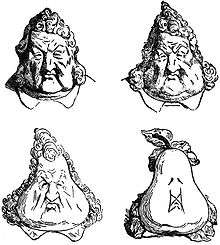

On 24 February 1848, during the February 1848 Revolution, King Louis Philippe abdicated in favour of his nine-year-old grandson, Philippe, comte de Paris. Fearful of what had happened to the deposed Louis XVI, Louis Philippe quickly left Paris under disguise. Unlike Louis, who attempted to escape France in extravagant transportation, he instead rode in an ordinary cab under the name of "Mr. Smith." He fled to England and spent his final years incognito as the 'Comte de Neuilly'.
The National Assembly of France initially planned to accept young Philippe as king, but the strong current of public opinion rejected that. On 26 February, the Second Republic was proclaimed. Louis Napoléon Bonaparte was elected President on 10 December 1848; on 2 December 1851, he declared himself president for life and then Emperor Napoleon III in 1852.
Louis Philippe and his family remained in exile in Great Britain in Claremont, Surrey, though a plaque on Angel Hill, Bury St. Edmunds claims that he spent some time there, possibly due to a friendship with the Marquess of Bristol, who lived nearby at Ickworth House. The royal couple spent some time by the sea at St. Leonards[15] and later at the Marquess's home in Brighton. Louis Philippe died at Claremont on 26 August 1850. He was first buried at St. Charles Borromeo Chapel in Weybridge, Surrey. In 1876, his remains and those of his wife were taken to France and buried at the Chapelle royale de Dreux, the Orléans family necropolis his mother had built in 1816, and which he had enlarged and embellished after her death.
Clash of the pretenders
The clashes of 1830 and 1848 between the Legitimists and the Orléanists over who was the rightful monarch were resumed in the 1870s. After the fall of the Second Empire, a monarchist-dominated National Assembly offered a throne to the Legitimist pretender, Henri de France, comte de Chambord, as Henri V. As he was childless, his heir was (except to the most extreme Legitimists) Louis Philippe's grandson, Philippe d'Orléans, comte de Paris. Thus the comte de Chambord's death would have united the House of Bourbon and House of Orléans.
However, the comte de Chambord refused to take the throne unless the Tricolor flag of the Revolution was replaced with the fleur-de-lis flag of the Ancien Régime. This the National Assembly was unwilling to do. The Third Republic was established, though many intended for it to be temporary, and replaced by a constitutional monarchy after the death of the comte de Chambord. However, the comte de Chambord lived longer than expected. By the time of his death in 1883, support for the monarchy had declined, and public opinion sided with a continuation of the Third Republic, as the form of government that, according to Adolphe Thiers, "divides us least". Some suggested a monarchical restoration under a later comte de Paris after the fall of the Vichy regime but this did not occur.
Many remaining French monarchists regard the descendants of Louis Philippe's grandson, who hold the title Count of Paris, as the rightful pretenders to the French throne; others, the Legitimists, consider Don Luis-Alfonso de Borbón, Duke of Anjou (to his supporters, "Louis XX") to be the rightful heir. Head of the Royal House of Bourbon, Louis is descended in the male line from Philippe, Duke of Anjou, the second grandson of the Sun-King, Louis XIV. Philippe (King Philip V of Spain), however, had renounced his rights to the throne of France to prevent the much-feared union of France and Spain.
The two sides challenged each other in the French Republic's law courts in 1897 and again nearly a century later. In the latter case, Henri, comte de Paris, duc de France, challenged the right of the Spanish-born pretender to use the title Duke of Anjou. The French courts threw out his claim, arguing that the legal system had no jurisdiction over the matter.
Honours
National
| Silver coin of Louis Philippe I, struck 1834 | |
|---|---|
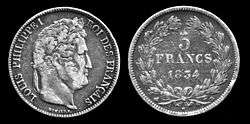 | |
| Obverse: (French) LOUIS PHILIPPE I, ROI DES FRANÇAIS, in English: "Louis Philippe I, King of the French" | Reverse: 5 FRANCS, 1834 |
- Knight of the Holy Spirit, 2 February 1789[16]
- Grand Cross of the Legion of Honour, 3 July 1816;[17] Grand Master, 9 August 1830
- Grand Cross of St. Louis, 10 July 1816[18]
- Grand Master of the Order of the Cross of July, 13 December 1830
Foreign
.svg.png)

.svg.png)
.svg.png)
.svg.png)

.svg.png)
.svg.png)
.svg.png)

Arms
.svg.png) Standard of Louis Philippe I
Standard of Louis Philippe I.svg.png) Coat of arms of Louis Philippe I
Coat of arms of Louis Philippe I
Territory
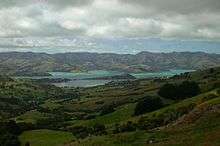
Port Louis-Philippe (Akaroa), the oldest French colony in the South Pacific and the oldest town in the Canterbury region of the New Zealand's South Island was named in honour of Louis Philippe who reigned as King of the French at the time the colony was established on 18 August 1840.[27] Louis Philippe had been instrumental in supporting the settlement project. The company responsible for the endeavour received Louis Philippe's signature on 11 December 1839 as well as his permission to carry out the voyage in line with his policy of supporting colonial expansion and the construction of a second empire which had first commenced under him in Algeria around a decade earlier.[28] The British Lieutenant-Governor Captain William Hobson subsequently went on to claim sovereignty over Port Louis-Philippe.
As a further honorific gesture to Louis Philippe and his Orléanist branch of the Bourbons, the ship on which the settlers sailed to found the eponymous colony of Port Louis-Philippe was named the Comte de Paris after Louis Philippe's beloved infant grandson, Prince Philippe d'Orléans, Count of Paris who was born on 24 August 1838.[28]
Issue
| Name | Picture | Birth | Death | Notes |
|---|---|---|---|---|
| Ferdinand Philippe, Duke of Orléans | 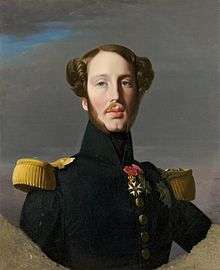 | 3 September 1810 | 13 July 1842 | Married Duchess Helene of Mecklenburg-Schwerin, had issue. |
| Louise d'Orléans |  | 3 April 1812 | 11 October 1850 | Married King Leopold I of Belgium, had issue. |
| Princess Marie d'Orléans | 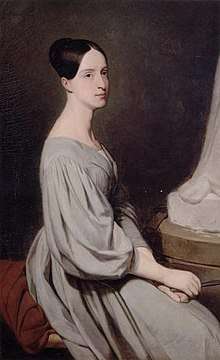 | 12 April 1813 | 6 January 1839 | Married Duke Alexander of Württemberg, had issue. |
| Louis, Duke of Nemours | 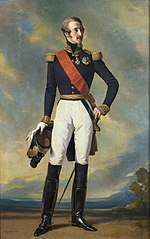 | 25 October 1814 | 26 June 1896 | Married Princess Victoria of Saxe-Coburg and Gotha, had issue. |
| Princess Françoise Louise Caroline d'Orléans | 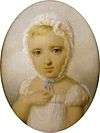 | 26 March 1816 | 20 May 1818 | Died aged two. Baptised on 20 July 1816, with Emperor Francis I of Austria as her godfather. |
| Clémentine d'Orléans |  | 6 March 1817 | 16 February 1907 | Married Prince August of Saxe-Coburg and Gotha, had issue. |
| François, Prince of Joinville | .jpg) | 14 August 1818 | 16 June 1900 | Married Princess Francisca of Brazil, had issue. |
| Charles d'Orléans | 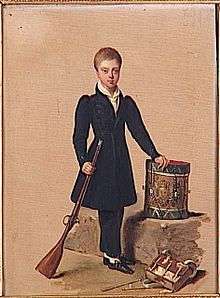 | 1 January 1820 | 25 July 1828 | Died aged eight. |
| Henri, Duke of Aumale | 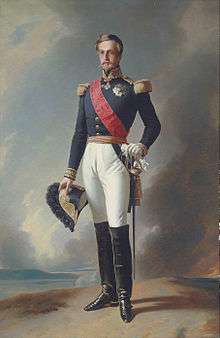 | 16 January 1822 | 7 May 1897 | Married Princess Caroline Auguste of the Two Sicilies, had issue-but no descendants survive. |
| Antoine, Duke of Montpensier | 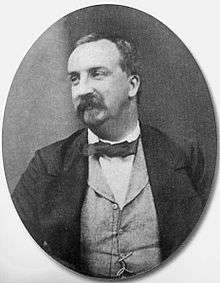 | 31 July 1824 | 4 February 1890 | Married Infanta Luisa Fernanda, Duchess of Montpensier, had issue. |
Ancestry
| Ancestors of Louis Philippe I[29] | |||||||||||||||||||||||||||||||||||||||||||||||||||||||||||||||||||||||||||||||||||||||||||||||||||||||||||||||||||||||||||||||||||||||||||||||||||||||||||||||||||||||||||||||||||||||||||||||||||||||||||||||||||||||||||||||||||||||||||||||||||||||||||||||||||||||||||||||||||||||||
|---|---|---|---|---|---|---|---|---|---|---|---|---|---|---|---|---|---|---|---|---|---|---|---|---|---|---|---|---|---|---|---|---|---|---|---|---|---|---|---|---|---|---|---|---|---|---|---|---|---|---|---|---|---|---|---|---|---|---|---|---|---|---|---|---|---|---|---|---|---|---|---|---|---|---|---|---|---|---|---|---|---|---|---|---|---|---|---|---|---|---|---|---|---|---|---|---|---|---|---|---|---|---|---|---|---|---|---|---|---|---|---|---|---|---|---|---|---|---|---|---|---|---|---|---|---|---|---|---|---|---|---|---|---|---|---|---|---|---|---|---|---|---|---|---|---|---|---|---|---|---|---|---|---|---|---|---|---|---|---|---|---|---|---|---|---|---|---|---|---|---|---|---|---|---|---|---|---|---|---|---|---|---|---|---|---|---|---|---|---|---|---|---|---|---|---|---|---|---|---|---|---|---|---|---|---|---|---|---|---|---|---|---|---|---|---|---|---|---|---|---|---|---|---|---|---|---|---|---|---|---|---|---|---|---|---|---|---|---|---|---|---|---|---|---|---|---|---|---|---|---|---|---|---|---|---|---|---|---|---|---|---|---|---|---|---|---|---|---|---|---|---|---|---|---|---|---|---|---|---|---|---|
| |||||||||||||||||||||||||||||||||||||||||||||||||||||||||||||||||||||||||||||||||||||||||||||||||||||||||||||||||||||||||||||||||||||||||||||||||||||||||||||||||||||||||||||||||||||||||||||||||||||||||||||||||||||||||||||||||||||||||||||||||||||||||||||||||||||||||||||||||||||||||
See also
- Louis Philippe style
- List of works by James Pradier
- Paris under Louis-Philippe
- Lieutenant-General (France)
- Origins of the French Foreign Legion
- Port Louis-Philippe (Akaroa)
Namesakes
- Louis Philippe, Crown Prince of Belgium, grandson by his daughter Queen Louise of the Belgians
- Luís Filipe, Prince Royal of Portugal, great-great-grandson and heir to the Portuguese Throne
Notes
- 'Louis Philippe's 13 August 1830 Ordinance, relative to the surname (nom) and titles of his children and of his sister':
Ordonnance du roi qui détermine les noms et titres des princes et princesses de la famille royale.
- LOUIS PHILIPPE ROI DES FRANÇAIS, à tous présens et à venir, salut.
- Notre bien-aimé fils aîné, le duc de Chartres, portera, comme prince royal, le titre de duc d'Orléans.
- Il sera fait, en conséquence, sur les registres de l'état civil de la Maison royale, dans les archives de la Chambre des Pairs, toutes les rectifications qui résultent des dispositions ci-dessus [...]
References
Citations
- Bukhari, Emir (1976). Napoleon's Dragoons and Lancers. p. 26. ISBN 0-85045-088-8.
- "Kom Inn! (NRK-TV Norsk Rikskringkasting)". tv.nrk.no. 12 September 1981.
- Corinne L. Saucier, History of Avoyelles Parish, p. 27 (1943).
- "Ealing and Brentford: Education - British History Online". www.british-history.ac.uk.
- Empires of the Plain: Henry Rawlinson and the Lost Languages of Babylon, Lesley Adkins, New York: Thomas Dunne Books, 2004
- Purdue, A.W. (2004). "George III, Daughters of (act. 1766–1857)". Oxford Dictionary of National Biography (online ed.). Oxford University Press. doi:10.1093/ref:odnb/59209. (Subscription or UK public library membership required.)
- Dyson. C.C, The Life of Marie Amelie Last Queen of the French, 1782–1866, BiblioBazaar, LLC, 2008.
- "Louis-Philippe Biography". The Biography.com Website. Retrieved 13 May 2014.
- "Louis-Philippe King of France". www.britannica.com. Retrieved 8 June 2019.
- "Les Miserables by Victor Hugo: Chapter III. Louis Philippe". www.online-literature.com.
- Bouveiron, A. "III." Historical and Biographical Sketch of Fieschi. N.p.: n.p., n.d. 16. Google Books. Web. 24 December 2012.
- Jill Harsin (2002). Barricades: The War of the Streets in Revolutionary Paris, 1830-1848. Palgrave Macmillan. ISBN 978-0-312-29479-3.CS1 maint: ref=harv (link)
- Gabriel G. Bredow; Carl Venturini (1837). Chronik des neunzehnten Jahrhunderts.CS1 maint: ref=harv (link)
- A. Bouveiron; Giuseppe Marco Fieschi (1835). An historical and biographical sketch of Fieschi. Sold at the office of the editor. p. 32.CS1 maint: ref=harv (link)
- Royal Victoria Hotel - Historical Hastings Wiki, accessdate: 22 May 2020
- Teulet, Alexandre (1863). "Liste chronologique des chevaliers de l'ordre du Saint-Esprit depuis son origine jusqu'à son extinction (1578–1830)" [Chronological List of Knights of the Order of the Holy Spirit from its origin to its extinction (1578–1830)]. Annuaire-bulletin de la Société de l'histoire de France (in French) (2): 111. Retrieved 24 March 2020.
- "Ordre de la Légion d'honneur: Textes officiels antérieurs à 1962". france-phaleristique.com (in French). Retrieved 26 March 2020.
- "Ordre royal et militaire de Saint-Louis". france-phaleristique.com (in French). Retrieved 26 March 2020.
- Almanach royal officiel, publié, exécution d'un arrête du roi, Volume 1: Tarlier, 1854, p. 37
- Jørgen Pedersen (2009). Riddere af Elefantordenen, 1559–2009 (in Danish). Syddansk Universitetsforlag. p. 245. ISBN 978-87-7674-434-2.
- "Herzogliche Sachsen-Ernestinischer Hausorden", Adreß-Handbuch des Herzogthums Sachsen-Coburg und Gotha (in German), Coburg, Gotha: Meusel, 1843, p. 6, retrieved 12 March 2020
- Militaire Willems-Orde: Bourbon, Louis Phillip prince de (in Dutch)
- "Caballeros existentes en la insignie Orden del Toison de Oro". Guía de forasteros en Madrid para el año de 1835 (in Spanish). En la Imprenta Nacional. 1835. p. 73.
- https://www.beaussant-lefevre.com/lot/86924/8138236?
- Almanacco reale del Regno delle Due Sicilie per l'anno ... dalla Real Tipografia del Ministero di Stato della Cancelleria Generale. pp. 459, 463.
- Shaw, Wm. A. (1906) The Knights of England, I, London, p. 57
- Reed, A. W. (2010). Peter Dowling (ed.). Place Names of New Zealand. Rosedale, North Shore: Raupo. p. 19. ISBN 9780143204107.
- Buick, T. Lindsay (1928). The French at Akaroa. p. 51.
- Father's side: Genealogie ascendante jusqu'au quatrieme degre inclusivement de tous les Rois et Princes de maisons souveraines de l'Europe actuellement vivans [Genealogy up to the fourth degree inclusive of all the Kings and Princes of sovereign houses of Europe currently living] (in French). Bourdeaux: Frederic Guillaume Birnstiel. 1768. p. 90.
- Bonhomme, Honoré (1869). Le duc de Penthièvre (Louis-Jean-Marie de Bourbon): sa vie, sa mort (1725–1793) d'après des documents inédits (in French). Firmin Didot Frères. p. 4.
- Delille, E. (1822). Journal de la vie de S.A.S. madame la Dsse. d'Orléans, douairière (in French). J.-J. Blaise. pp. 1–2.
- Genealogie ascendante, p. 86
Bibliography
- Aston, Nigel. "Orleanism, 1780–1830," History Today, Oct 1988, Vol. 38 Issue 10, pp 41–47
- Beik, Paul. Louis Philippe and the July Monarchy (1965)
- Collingham, H.A.C. The July Monarchy: A Political History of France, 1830–1848 (Longman, 1988)
- Howarth, T.E.B. Citizen-King: The Life of Louis Philippe, King of the French (1962).
- Jardin, Andre, and Andre-Jean Tudesq. Restoration and Reaction 1815–1848 (The Cambridge History of Modern France) (1988)
- Lucas-Dubreton, J. The Restoration and the July Monarchy (1929)
- Newman, Edgar Leon, and Robert Lawrence Simpson. Historical Dictionary of France from the 1815 Restoration to the Second Empire (Greenwood Press, 1987) online edition
External links
| Wikiquote has quotations related to: Louis Philippe I |
| Wikisource has the text of the 1911 Encyclopædia Britannica article Louis Philippe I. |

- La Caricature Gallery: Caricatures of Louis Philippe and others, published in La Caricature 1830–1835
Louis Philippe I Cadet branch of the House of Bourbon Born: 6 October 1773 Died: 26 August 1850 | ||
| Regnal titles | ||
|---|---|---|
| Preceded by Charles X as King of France |
King of the French 9 August 1830 – 24 February 1848 |
Vacant Title next held by Napoleon IIIas emperor |
| Preceded by Charles X of France |
Co-Prince of Andorra with Simó de Guardiola 9 August 1830 – 24 February 1848 |
Succeeded by Louis-Napoleon Bonaparte |
| French nobility | ||
| Preceded by Louis Philippe II |
Duke of Orléans 6 November 1793 – 9 August 1830 |
Succeeded by Ferdinand Philippe |
| Political offices | ||
| Preceded by Charles X |
French Head of State 9 August 1830 – 24 February 1848 |
Succeeded by Jacques-Charles Dupont de l'Eure |
| Titles in pretence | ||
| Loss of title Republic declared |
— TITULAR — King of the French 24 February 1848 – 26 August 1850 |
Succeeded by Philippe VII/Louis Philippe II |
